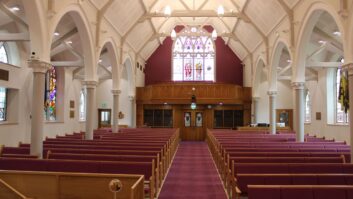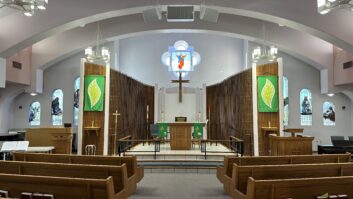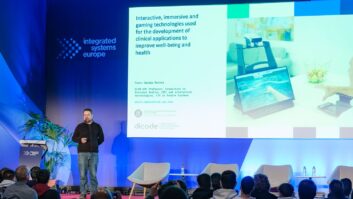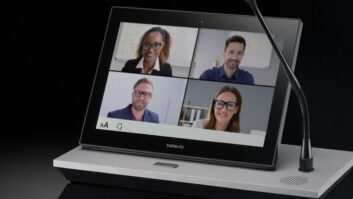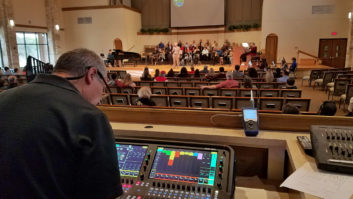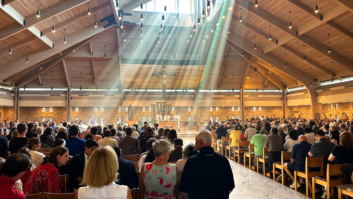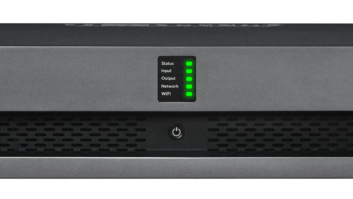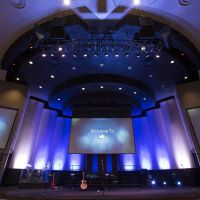
Danley Sound Labs loudspeakers and subs contribute to true stereo imaging at First Free Church in Rockford, Illinois. First Free Church has been a cornerstone of spiritual life in Rockford, Illinois since 1884. Over the decades, First Free has occupied several buildings of ever-growing size and, since the advent of AV technology, ever-growing technical sophistication. Its current sanctuary seats close to 1,800 congregants in an arc spanning nearly 180 degrees, with a balcony and under-balcony area that stretches from wall to wall.
Tired of poor coverage from a faux-LCR system of mid-1990s vintage, First Free hired SVL Productions of nearby Cherry Valley, Illinois to build a new system that would provide nearly every seat with crisp stereo imaging. SVL Productions turned to Chicago-based Johnson AV Engineering to help design and commission the new system, which relies on the tight pattern control of Danley Sound Labs loudspeakers to meet – and then greatly exceed – the church’s expectations.
“Music is a vital component of First Free’s services,” said Aaron Johnson, president and principal engineer at Johnson AV Engineering. “The old system had three clusters to cover different wedges of the room’s wide arc, but despite the fact that they were set up as a Left-Center-Right system, none of the seats had any true imaging to speak of. The church wanted true imaging, where each instrument seems to emanate from the empty space between the loudspeakers, but that’s very hard to achieve in such a wide arc. You can’t simply place a couple of clusters on either side of the stage and expect even coverage and convincing imaging. The relative volume and time delay of each loudspeaker at the listener’s location have to be nearly equal to make the stereo effect work.” The solution was to divide the room into three 60-degree wedges, each of which would receive its own stereo image. Although that’s easy to conceptualise, it’s very difficult to implement because almost all loudspeakers spill energy “off-axis.” That spillover would cross the dividing line between one wedge and the next and destroy the stereo imaging effect. “Danley’s tight pattern control made it the obvious choice for this application,” said Johnson. “No other loudspeaker manufacturer comes close to Danley’s razor-sharp pattern control, which extends even to lower frequencies.” Because of their specific coverage patterns and the geometry of the room, Johnson specified a Danley SH-60 on top of a Danley SM-96 at each loudspeaker location for coverage of the main seating area. A total of six such clusters comprise the main system: three sets of left and right. Four monophonic Danley SH-Micros provide front fill for seats very near the stage. Partitions separate six under-balcony areas, four of which seat 30-40 each and two of which seat only eight. For the larger partitions, a stereo pair of Danley SH-Micros deliver convincing stereo imaging, whereas a single Danley SH-Micro in each of the smaller partitions deliver a monophonic summed signal. Johnson also designed a directional subwoofer cluster comprised of three Danley TH-118s flown near the ceiling, just in front of the stage. By paying careful attention to each unit’s phase and signal delay, the bass volume on stage is a full 18 dB lower than it is in the seats, which is an obvious and significant difference. The dividing line is, in Johnson’s words, “like a curtain,” and even the first row of seats is fully immersed in bass. By keeping so much low-frequency energy off the stage, the sound quality captured on stage by open microphones is much better and far less likely to growl or feed back. Processing support for the new system is extensive, as proper alignment required a separate processing channel for almost every individual loudspeaker and subwoofer. BiAmp Audia provides that fine-scale level of control. Because the Danley loudspeakers and subwoofers require only a single amplifier channel, the total number of amplifiers was kept to a minimum, but the sheer number of loudspeakers and subwoofers involved still amounted to an impressive 26 channels.
Powersoft K-Series and Ottocanali-Series amplifiers provide that power. “The new system requires more power to the loudspeakers and subs than the old system did, but the efficiency of the Powersoft units allow us to draw less AC power,” said Hayes. “As a result, we didn’t have to call in an electrician. Moreover, their physical compactness left an entire rack from the previous installation wide open. In summary, we had more processing channels, more amplifier channels, and more loudspeaker power, but less current draw and less space consumed.” New video projectors and screens, together with a new high-end Chauvet lekos and LED lights completed the installation. www.danleysoundlabs.com
